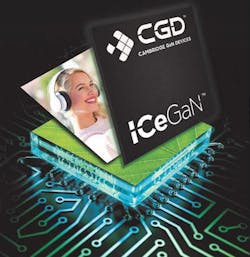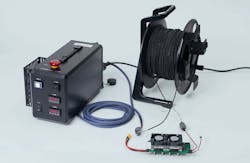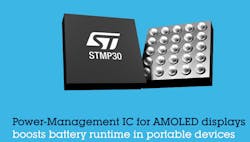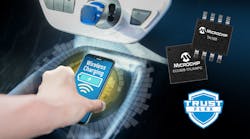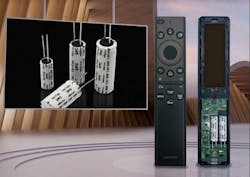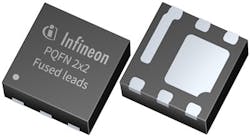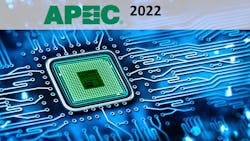This Week in PowerBites: Rescue Drones, Good Climate Change News
This article is part of the This Week in PowerBites Library Series.
Single-Chip 650-V Enhancement-Mode GaN Devices: Integrated Protection, MOSFET-Like Drive Attributes
Cambridge GaN Devices Ltd. (CGD) emerged from stealth mode at the 2022 APEC power conference to announce the launch of its first portfolio of products. CGD says that its patented enhancement-mode GaN (ICeGaN) technology makes designing with any of the four devices in the 650V H1 series nearly as straightforward as using conventional MOSFETs, while delivering the speed and low power losses of a standard GaN power device.
CGD’s H1 Series are single-chip eMode HEMT devices, based on the company's ICeGaN technology, which combines the ease-of-use offered by cascode configurations with the simplicity of single-die enhancement-Mode (normOFF) HEMTs. All H1 devices have a 3-V threshold voltage, real 0-V turnOFF, and a unique gate structure that can tolerate input voltages as high as 20 V. Their benign, MOSFET-like characteristics facilitate upgrades of existing designs by replacing their silicon-based power devices.
The company’s unique fabrication technology also enabled the integration of several smart sense and protection features. The result is a single-die solution that can be driven using standard, low-cost MOSFET drivers that requires no external protection components. It reduces power losses by up to 50%, as compared to a legacy silicon die. All CGD's H1 Series transistors come with low-profile, low-inductance DFN packages that incorporate a Kelvin pin for optimized high-frequency, low-noise operation.
CGD is initially targeting consumer applications that include mobile chargers, adapters for laptops, gaming and all-in-one (AIO) computers, and, in general, SMPS for consumer apps. The company says that it expects to expand into other segments, beginning with lighting and server power, with future plans for renewable-energy systems and EVs.
For additional information, datasheets, and application notes, visit https://camgandevices.com/p/products/.
Rescue Drones Provide Life-Saving Communications for First Responders
When natural disasters occur, restoring communications is essential for first responders. They count on cellular and internet services to coordinate the delivery of time-critical care to victims and restore essential services such as drinking water, food, and electricity.
In Japan, a new system is being deployed that uses high-powered tethered drones to restore emergency communications within minutes of first responders' arrival on the scene. These lightweight, portable drones, equipped to serve as mobile communication base stations, were developed by a consortium of major telecommunications carriers. The goal was to provide near-instant communication capabilities for first responders.
Most of the development effort involved repurposing and integrating existing technologies and some existing commercial products, but several systems required a new approach. One of the most notable engineering tasks was creating the tethered power system that would allow the drone to remain aloft for hours, or even days, at a time.
This task fell to the Japanese engineering company, Fukaden Corp., which developed the Power Control BOX II Main Power Supply Unit that delivers power via a tether to the drone. It enables 1 kW of power to be delivered up to 150 meters.
Higher Voltage Allows for Lighter, Thinner Cable
Historically, the drawback of tethered drones has been the thickness and weight of the power cable. Long, heavy cable adds weight that creates more drag. Thus, it requires more power and limits the ability to add new features to the drone, such as sensors or high-resolution video cameras. Since their drones need 1 to 5 kW of power, the tether's weight and thickness became a major issue.
Fukaden engineers solved this problem by increasing the supply voltage from 24 to 370 V, a move that reduces supply current by 15X, and enables the use of a thinner tether cable. Applying the higher voltage reduces the weight of the 1-kW tether cable by more than 10X, from 125 g to 11.1 g per meter.
Running 370 V up to the drone requires installation of a high-density, lighter dc-dc converter module in the drone to step the power down to 24 V dc, which is needed to drive the motor.
The initial Fukaden high-voltage dc-dc converter design was heavy and consumed too much space. So, the company searched for a small, lightweight dc-dc converter. In the end, they selected a Vicor DCM power module, an isolated dc-dc converter module that uses high-frequency, zero-voltage-switching (ZVS) technology and is characterized by high conversion efficiency and high output-power density. Using the DCM reduced the volume by 75% and cut the weight by more than 50%.
Fukaden has already conducted demonstration tests on the unit and says that the design can be scaled easily by using units in parallel to triple the power to 3 kW, which provides cellular service to a 10 km diameter. The company says that with the added power, the drone will be able to fly for 92 hours and maintain a communication area diameter of 10 km. The improved performance also enhances the base station’s performance in all types of inclement weather.
Fukaden also is working on its next generation of larger, more capable communication drones that will require up to 9 kW. Keeping the tether thin enough to permit flight will require an operating voltage of 700 V dc, which was verified during recent tests. Three higher-voltage BCM bus converters were used in parallel to deliver up to 4.5 kW.
The company’s portable base-station units are helping the rescue drones become part of first responder's essential equipment kit for responding to natural disasters in Japan. It’s expected that their versatility and portability also will be adopted to deliver essential communications to first responders in many other parts of the world.
Click here for more information about Vicor's DCM family of voltage converters. And click here to learn more about Fukaden.
AMOLED PMIC Boosts Viewing Experience and Battery Runtime in Portable Devices
STMicroelectronics’ fully integrated power-management IC (PMIC) for AMOLED displays offers low quiescent current and enhanced flexibility to extend the battery runtime of portable devices. With an input-voltage range from 2.9 to 4.8 V, the STMP30 PMIC contains three integrated dc-dc converters to provide all of the power rails required for AMOLED displays in smartphones and other portable devices.
The PMIC's 550-mA VOUT1 boost converter has an adjustable output voltage that can be set between 4.6 and 5.0 V, in 100-mV increments. While many competing devices’ VOUT1 is fixed at 4.6 V, the STMP30's variable output allow the display brightness to be optimized for lowest power consumption and best visibility under any conditions. The 5.0-V maximum setting allows for the use of a high-brightness mode (HBM) for best viewing in bright outdoor lighting.
The remaining two outputs are provided by a 550-mA, single-phase, buck-boost inverting converter with an output that's programmable from −0.8 to −6.6 V, and a 150-mA boost converter that can be programmed to deliver 5.5 to 7.9 V. All three output voltages can be programmed through external pins using the industry-standard Single-Wire (S-Wire) protocol. The PMIC also receives S-Wire messages to operate the AMOLED in Always-On Display (AOD) mode, which improves user convenience by showing information on-screen continuously at very low power.
Other features include a true shutdown mode that helps maximize power savings, as well as safety features including thermal protection, input undervoltage lockout, and soft-start with inrush current limiting. In addition, the high-voltage outputs feature fast-discharge circuitry, and offer short-circuit protection.
ST’s STMP30 AMOLED PMIC is in volume production now. Please contact your ST sales office for pricing options and sample requests.
Superjunction MOSFET Family Gains Four Improved 650-V Devices
Toshiba Electronics added four new N-channel, superjunction 650-V power MOSFET devices to its DTMOSVI series. They offer enhanced efficiency and performance for applications like industrial and lighting power supplies and other products that demand high efficiency and small form factors.
The TK090E65Z, TK110E65Z, TK155E65Z, and TK190E65Z MOSFETs achieve a 40% reduction in the drain-source on-resistance (RDS(ON)) × gate-drain charge (Qgd) figure of merit (FoM) when compared to the previous generation of DT-MOSFETs. In practical terms, the improved FoM results in substantially lower switching losses over earlier devices that enhance the efficiency of new designs, and it enables easy upgrades of existing designs.
All four new devices offer a drain-source voltage (VDSS) of 650 V with a drain current (ID) capability up to 30 A. Drain-source RDS(ON) is as low as 0.09 W and the Qgd can be as low as 7.1 nC, enabling low-loss operation at high speeds. All devices are packaged in standard TO-220 through-hole packages.
For further information, go here.
Secure Key Storage and Authentication Devices Support WPC's Qi 1.3 Spec
A new series of key storage and authentication devices from Microchip Technology simplify the design of secure wireless charging products that comply with the Wireless Power Consortium's (WPC) Qi 1.3 specification and its associated extended power profile. The industrial-grade TrustFLEX ECC608 and the automotive-grade Trust Anchor TA100 can be combined with Microchip’s secure key provisioning services for Qi 1.3 power transmitters to form an all-in-one secure storage subsystem. The subsystem thus would feature key provisioning for consumer and automotive systems.
The solution was developed to support the new Qi 1.3 specification, which mandates the addition of a secure storage subsystem with secure key provisioning, including X.509 certificates to cryptographically verify the source and quality of the certified power transmitter.
When a receiver, embedded in a cellphone or other mobile device, is placed on a Qi 1.3 power transmitter, it may initially accept a 5-W charge or no charge at all. Then after a successful X.509-based ECC authentication that proves the charger is an approved, "do no harm" device, the phone will then safely accept a 15-W charge, thereby significantly reducing charging time.
As a WPC-licensed manufacturing certificate authority (CA), Microchip can provide preconfigured secure storage subsystem solutions that reduce complexity and development time. It also can handle the entire key ceremony with the WPC root CA on behalf of Microchip customers. Furthermore, it provides complete certified reference designs, such as application MCU, Qi 1.3 software stack, secure storage subsystems with supporting crypto library, along with provisioning services for both automotive and consumer applications.
Development Tools
The chipset's development platform includes:
- The CryptoAuth Trust Platform Development Kit (DM320118), which supports Microchip’s ECC608 TrustFLEX device.
- The TA100, which will require the TA100 8-pin SOIC Socket Board (AC164166) or TA100 24-VQFN Socket Board (EV39Y17A) to plug into the CryptoAuth Trust Platform Development kit.
- Microchip also offers the Trust Platform Design Suite software-development tool for secure storage subsystems and a certified WPC Qi1.3 reference design.
Availability
- Both the ECC608-TFLXWPCS and the ECC608-TFLXWPCU cost $0.90 for up to 10,000 units.
- The TA100, in SOIC8 and VQFN24 packages, is available starting at $1.50 in 10,000-unit quantities.
- For additional information or to purchase products mentioned here, contact a Microchip sales representative, authorized worldwide distributor, or visit Microchip’s website.
Industry's First Battery-Free TV Remote Uses Eco-Friendly Hybrid Supercapacitors
VINATech Co. announced that its VPC (Vina Pulse Capacitor) hybrid capacitors are being used in the solar-cell-equipped TV remote control for Samsung Electronics' recently launched Neo QLED TV. According to VINATech, it’s the first time that a hybrid capacitor has completely replaced the battery as the main power source in a TV remote control.
The Eco Remote uses a combination of the VINATech VPC hybrid capacitor, a photovoltaic cell, and energy-harvesting technology to enable charging to take place even in the dark. VPC is a high-power-density, eco-friendly hybrid capacitor that combines the advantages of supercapacitors and batteries by using different materials for both electrodes.
A supercapacitor is suitable for short bursts of high instantaneous power output. It offers high-speed charging and discharging, long lifespan, and wide operating temperature range, but has less energy density than batteries.
In contrast, VPCs have an energy density that’s about 10X higher than a supercapacitor of equivalent size. VPCs also retain the advantages of supercapacitors, such as a faster charging and discharging speed than batteries, and the ability to operate in a wide temperature range from −25 to 85°C. In addition, unlike batteries, there’s no risk of fire or explosion with a VPC.
VPCs are made of eco-friendly materials that help to minimize carbon-dioxide emissions in the entire lifecycle from production to disposal. VPCs also are optimized for eco-friendliness because they have a charging/discharging lifespan of more than 50,000 cycles—100X times longer than typical Li-ion cells. Samsung Electronics estimates that using VPCs in its products could eliminate the need for more than 200 million batteries per year, which, if arranged in a line, would extend from Las Vegas (USA) to South Korea.
For additional information, click here.
Low-Voltage Power MOSFETs in PQFNs Offer Ultra-Low On-Resistance, Superior Switching Performance
Infineon Technologies introduced a new series of low-voltage OptiMOS power MOSFETs, housed in 2- × 2-mm2 PQFN packaging. Rated for 5, 25, and 30 V, the new devices combine thin wafer technology and advanced packaging innovation to deliver extremely low on-resistance (RDS(ON)), high efficiency, and an extremely small form factor.
These products' characteristics have been optimized for synchronous rectification in switched-mode power supplies (SMPS) for servers, telecom bricks, portable chargers, and wireless charging. Infineon’s integrated power MOSFET also is well-suited for applications where weight and space are at a premium, such as the electronic speed controls (ESC) for the small brushless motors used in drones.
The PQFN 2x2 devices' compact package footprint offers PCB layout routing flexibility, which further contributes to the power density and compact form factor of the end application. Their reduced system temperature and improved performance usher in more relaxed thermal management requirements, significant space savings, and reduced system costs.
The new, commercially available members of the OptiMOS family of power MOSFETs are:
- PQFN 2x2 25 V: 2 × 2 mm2, RDS(ON) 2.4 mΩ (ISK024NE2LM5)
- PQFN 2x2 30 V: 2 × 2 mm2, RDS(ON) 3.6 mΩ (ISK036N03LM5)
Additional information (links to datasheets, pricing) is available at OptiMOS 5 25 V/30 V. For more on creating energy-efficient designs for "green" applications can be found at www.infineon.com/green-energy.
New Report Outlines Practical, Profitable Strategies for Beating Climate Change
The latest report from the Intergovernmental Panel on Climate Change (IPCC) offers up some surprisingly good news about how the crisis can be successfully addressed, and the economic benefits that it will create for governments, businesses, and citizens. While it still offers a grim preview of what's coming if the global economy doesn't sharply curtail its use of fossil fuels, the report provides a detailed series of realistic policy changes and technology strategies that can support a shift to a sustainable, prosperous future.
A significant part of the report is devoted to detailing what it will take to reduce world's energy systems, buildings and urban systems, transportation, agriculture, and other industries' climate footprints. It also summarizes the dividends those investments will yield and, in some cases, are already producing. This is being made possible in good part by the steady decline in the cost of key technologies, such as solar, wind, batteries, and electric vehicles, and the resulting growth in their market share (as documented in the report's technical summary, p. 28).
Since the issues involved with this transformation are very complex, it's easier to understand the process by looking at how they’re applied to a single sector of the economy. "Four Lessons for Cities" published by the Rocky Mountain Institute does just that with a clear summary of the IPCC's proposed actions for making cities sustainable, what it will take to implement these policies, and the multi-dimensional dividends they will produce. Among other things, it looks at the three strategies recommended by the IPCC report for cities to dramatically reduce their emissions:
- Reduce urban energy consumption across all sectors, including through land use and transportation planning and infrastructure.
- Electrify and switch to net-zero emissions resources.
- Enhance carbon stocks and uptake through urban green and blue infrastructure, which also can offer multiple co-benefits.
In addition, the article explains why investments in electrifying mobility, heating, and cooling systems, and decarbonizing the electric grid, are critical strategies for urban climate mitigation. For example, electrification and energy efficiency can help cities globally reduce emissions by 6.9 gigatons of CO2e by 2030 and 15.3 GtCO2e by 2050. Integrating solar PV and all electric vehicles alone could supply affordable clean energy to cities and reduce CO2 emissions by 54-95%.
As Jon Creyts, RMI’s Chief Program Officer says, “The outcome of this large-scale transformation is not only a habitable world, but also one that promises to be cleaner, fairer, healthier, and more resilient for all.”
Trend-Spotting at APEC 2022
This year’s Applied Power Electronics Conference (APEC) is over, but the innovations that made their debut in Houston will have a profound and lasting impact on all sectors of the power universe. In anticipation, ED dispatched James Morra and Yours Truly to cover the torrent of news being made at the show.
Although attendance was roughly half of pre-pandemic levels, it didn't seem to affect the number of market-changing products and technologies being introduced. In fact, James and I noted that they seemed to be in even greater abundance than usual.
We collected together all of the stories and videos we produced APEC here. Several of them are examples of important trends we observed that have the potential to shape the power industry.
- The tremendous effort behind making GaN and SiC devices easier to design into products has begun to pay off handsomely. Companies like UnitedSiC and Cambridge GaN Devices are using integrated electronics and novel transistor architectures to give their devices MOSFET-like characteristics, while companies like TI, Microchip, and Infineon have developed smart gate drivers that provide the unique drive signals and protection that WBG devices need. You can find several examples in James Morra's "New Products Push Power Further at APEC 2022” Part 1 and Part 2.
- 2022 marks the year that GaN has entered the mainstream market in a conspicuous fashion, perhaps most notably in high-power USB-C power converters. Power Integrations upped the ante with a GaN-based converter capable of delivering 200+ W and a companion power-factor-correction (PFC) device that simplifies compliance with global eco-standards.
- In addition to their awesome speed and efficiency, other unique properties of GaN and SiC devices are enabling the rise of new conversion architectures, and breathing life into classics such as the "totem pole" converter. Check out this video with onsemi's Ajay Hari, who explains how this enhanced converter works and some of the applications it makes possible.
Read more articles in the This Week in PowerBites Library Series

